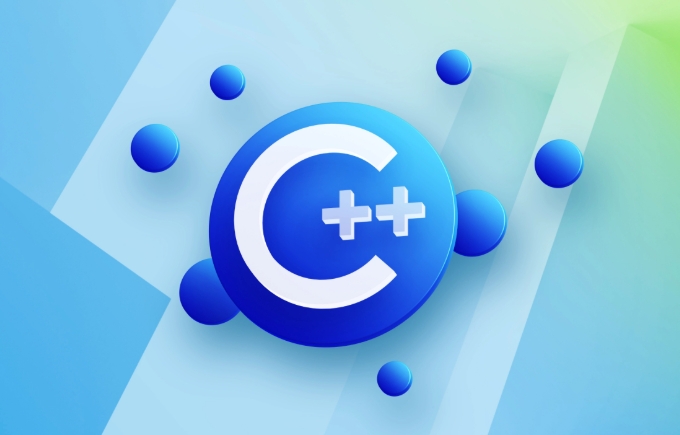什么是C 17中的STD ::文件系统?
std::filesystem in C 17 是一个用于跨平台文件系统操作的标准库模块,提供了path、file_status、directory_entry等核心组件,支持检查文件存在性、遍历目录、创建删除目录及处理路径等功能。1. 它取代了以往依赖平台API或第三方库的做法;2. 支持常见操作如exists()、create_directory()、directory_iterator等;3. 自动处理不同系统的路径格式差异;4. 使用时需注意异常处理、平台差异和性能问题。

std::filesystem in C 17 is a standard library module that provides a set of classes and functions for manipulating files, directories, and paths in a portable way. Before C 17, developers often relied on platform-specific APIs or third-party libraries like Boost to handle file system operations. Now, with std::filesystem, you can write code that works across different operating systems without needing external dependencies.

Key Features of std::filesystem
The main components of std::filesystem include:

- path: Represents a filesystem path (file or directory), handling string conversions, concatenation, and more.
- file_status: Holds information about a file’s type and permissions.
- directory_entry: Represents an entry in a directory.
- directory_iterator: Iterates through the contents of a directory.
- recursive_directory_iterator: Traverses directories recursively.
-
Functions for checking file existence (
exists()), copying files (copy_file()), creating directories (create_directory()), getting file size (file_size()), and more.
These tools make it easier to work with files and folders without relying on OS-specific calls.
Common Use Cases and Examples
Here are some everyday tasks you can do with std::filesystem.

Check if a File Exists
This is one of the most basic but essential operations:
#include <filesystem>
namespace fs = std::filesystem;
if (fs::exists("example.txt")) {
std::cout << "File exists\n";
}You can also check if it's a regular file or a directory using is_regular_file() or is_directory().
List Files in a Directory
Use directory_iterator to loop through files:
for (const auto& entry : fs::directory_iterator(".")) {
std::cout << entry.path() << "\n";
}This prints all files and folders in the current working directory.
If you need to go into subdirectories too, just replace directory_iterator with recursive_directory_iterator.
Create and Remove Directories
Creating a directory is straightforward:
fs::create_directory("new_folder");And removing one:
fs::remove_all("new_folder"); // Removes even if not emptyNote: remove() deletes only empty directories. For non-empty ones, use remove_all().
Handling Paths Correctly
One of the biggest advantages of std::filesystem is how it handles paths consistently across platforms. You don’t have to worry about backslashes vs. forward slashes — it takes care of that under the hood.
For example:
fs::path p = "data" / "images" / "logo.png"; std::cout << p; // Outputs "data/images/logo.png" on Linux/macOS, "data\images\logo.png" on Windows
You can also extract parts of a path easily:
-
p.parent_path()returns"data/images" -
p.filename()gives"logo.png" -
p.extension()gives".png"
This makes building and parsing paths much cleaner than using string manipulation.
Things to Watch Out For
While std::filesystem is powerful, there are a few gotchas:
- It may throw exceptions by default. If you don't want that, pass an error code object as the last argument to many functions.
- Not all operating systems support every feature — for example, certain permission-related functions behave differently on Windows and Unix-like systems.
- Performance can be an issue when iterating large directories or deeply nested structures.
So always test your code on target platforms and consider wrapping filesystem calls in try-catch blocks unless you're sure they won’t fail.
That's the core of what you need to know about std::filesystem. It’s not overly complicated, but it does take some time to get used to the types and methods. Once you’re familiar with them, though, it becomes a solid part of your C toolkit for file management.
以上是什么是C 17中的STD ::文件系统?的详细内容。更多信息请关注PHP中文网其他相关文章!

热AI工具

Undress AI Tool
免费脱衣服图片

Undresser.AI Undress
人工智能驱动的应用程序,用于创建逼真的裸体照片

AI Clothes Remover
用于从照片中去除衣服的在线人工智能工具。

Clothoff.io
AI脱衣机

Video Face Swap
使用我们完全免费的人工智能换脸工具轻松在任何视频中换脸!

热门文章

热工具

记事本++7.3.1
好用且免费的代码编辑器

SublimeText3汉化版
中文版,非常好用

禅工作室 13.0.1
功能强大的PHP集成开发环境

Dreamweaver CS6
视觉化网页开发工具

SublimeText3 Mac版
神级代码编辑软件(SublimeText3)
 c认识python的人的教程
Jul 01, 2025 am 01:11 AM
c认识python的人的教程
Jul 01, 2025 am 01:11 AM
学Python的人转学C 最直接的困惑是:为什么不能像Python那样写?因为C 虽然语法更复杂,但提供了底层控制能力和性能优势。1.语法结构上,C 使用花括号{}而非缩进组织代码块,且变量类型必须显式声明;2.类型系统与内存管理方面,C 没有自动垃圾回收机制,需手动管理内存并注意释放资源,使用RAII技术可辅助资源管理;3.函数与类定义中,C 需要明确访问修饰符、构造函数和析构函数,并支持如运算符重载等高级功能;4.标准库方面,STL提供了强大的容器和算法,但需要适应泛型编程思想;5
 C中的多态性:综合指南
Jun 21, 2025 am 12:11 AM
C中的多态性:综合指南
Jun 21, 2025 am 12:11 AM
C 中的多态性分为运行时多态性和编译时多态性。1.运行时多态性通过虚函数实现,允许在运行时动态调用正确的方法。2.编译时多态性通过函数重载和模板实现,提供更高的性能和灵活性。
 C驱动器:实用的代码示例
Jun 22, 2025 am 12:16 AM
C驱动器:实用的代码示例
Jun 22, 2025 am 12:16 AM
c destructorSarespecialememberfunctionsthatautapityReleSoursoursoursoursoursoursoursOutgoesOutofScopeOrisdelet.1)shemarecrucialformanagingmemory,filehandles,andNetworkConnections.2)初学者
 c标准模板库(STL)的教程
Jul 02, 2025 am 01:26 AM
c标准模板库(STL)的教程
Jul 02, 2025 am 01:26 AM
STL(标准模板库)是C 标准库的重要组成部分,包含容器、迭代器和算法三大核心组件。1.容器如vector、map、set用于存储数据;2.迭代器用于访问容器元素;3.算法如sort、find用于操作数据。选择容器时,vector适合动态数组,list适合频繁插入删除,deque支持双端快速操作,map/unordered_map用于键值对查找,set/unordered_set用于去重。使用算法时应包含头文件,并配合迭代器和lambda表达式。注意避免失效迭代器、删除时更新迭代器、不可修改m
 C竞争性编程教程
Jul 02, 2025 am 12:54 AM
C竞争性编程教程
Jul 02, 2025 am 12:54 AM
学C 冲着打比赛应从以下几点入手:1.熟练基础语法但不必深入,掌握变量定义、循环、条件判断、函数等基本内容;2.重点掌握STL容器如vector、map、set、queue、stack的使用;3.学会快速输入输出技巧,如关闭同步流或使用scanf和printf;4.利用模板与宏简化代码书写,提高效率;5.多刷题熟悉边界条件、初始化错误等常见细节问题。
 c带有OpenGL的图形编程教程
Jul 02, 2025 am 12:07 AM
c带有OpenGL的图形编程教程
Jul 02, 2025 am 12:07 AM
作为C 程序员入门图形编程,OpenGL是一个好的选择。首先需搭建开发环境,使用GLFW或SDL创建窗口,配合GLEW或glad加载函数指针,并正确设置上下文版本如3.3 。其次理解OpenGL的状态机模型,掌握绘制核心流程:创建编译着色器、链接程序、上传顶点数据(VBO)、配置属性指针(VAO)并调用绘制函数。此外要熟悉调试技巧,检查着色器编译与程序链接状态,启用顶点属性数组,设置清屏颜色等。推荐学习资源包括LearnOpenGL、OpenGLRedBook及YouTube教程系列。掌握上述
 C中的标准模板库(STL)是什么?
Jul 01, 2025 am 01:17 AM
C中的标准模板库(STL)是什么?
Jul 01, 2025 am 01:17 AM
C STL是一组通用模板类和函数,包含容器、算法、迭代器等核心组件。容器如vector、list、map、set用于存储数据,vector支持随机访问,适合频繁读取;list插入删除高效但访问慢;map和set基于红黑树,自动排序适用于快速查找。算法如sort、find、copy、transform、accumulate封装常用操作,作用于容器的迭代器范围。迭代器作为连接容器与算法的桥梁,支持遍历和访问元素。其他组件包括函数对象、适配器、分配器,用于定制逻辑、改变行为及内存管理。STL简化了C
 如何在C中使用CIN和COUT进行输入/输出?
Jul 02, 2025 am 01:10 AM
如何在C中使用CIN和COUT进行输入/输出?
Jul 02, 2025 am 01:10 AM
在C 中,cin和cout用于控制台输入输出。1.使用cout读取输入,注意类型匹配问题,遇到空格停止;3.读取含空格字符串时用getline(cin,str);4.混合使用cin和getline时需清理缓冲区残留字符;5.输入错误时需调用cin.clear()和cin.ignore()处理异常状态。掌握这些要点可编写稳定的控制台程序。







